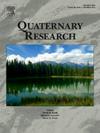利用澳大利亚库罗拉沙地沙丘脚坡沉积物重建全新世火灾记录
IF 1.8
3区 地球科学
Q3 GEOGRAPHY, PHYSICAL
引用次数: 1
摘要
摘要在这项研究中,我们评估了澳大利亚东部亚热带海岸沙丘系统库卢拉沙团内风成沉积物的木炭记录,以确定它们是否可以作为全新世火灾史的代表。我们在沙丘滑面(脚坡沉积物)底部的沉积楔中挖掘了四个剖面,并以预定的深度间隔计算了三个尺寸类别(180–250μm、250–355μm和355μm–2 mm)的木炭浓度。使用放射性碳测量(n=46)和基础光激发光年龄(n=4)为每个剖面构建年龄-深度模型。所有记录都完好无损,几乎没有沉积后混合的证据,这可以从最小的年龄逆转和不同大小类别的木炭浓度和堆积率(CHAR)的一致趋势中看出。结合所有四个记录,我们生成了一个约7卡BP的地面火灾历史,该历史描绘了不同的峰值,代表<0.3、1.1-0.4、2.2-1.6、3.4-2.6和6.7-5.3卡BP的局部火灾活动增加时期。我们的发现与区域记录相平行,并强调了沙丘坡脚作为生态和沉积档案的实用性。在半干旱和干旱地区,沙丘地比湿地和湖泊更常见,这些沉积物有可能提高全球火灾记录的空间分辨率。本文章由计算机程序翻译,如有差异,请以英文原文为准。
Reconstructing Holocene fire records using dune footslope deposits at the Cooloola Sand Mass, Australia
Abstract In this study, we assess charcoal records from eolian deposits within the Cooloola Sand Mass, a subtropical coastal dune system in eastern Australia, to determine whether they can be used as a proxy for Holocene fire history. We excavate four profiles in depositional wedges at the base of dune slipfaces (footslope deposits) and calculate charcoal concentrations for three size classes (180–250 μm, 250–355 μm, and 355 μm–2 mm) at predetermined depth intervals. Age–depth models are constructed for each profile using radiocarbon measurements (n = 46) and basal optically stimulated luminescence ages (n = 4). All records appear intact with little evidence of postdepositional mixing as demonstrated by minimal age reversals and consistent trends in charcoal concentration and accumulation rates (CHAR) among size classes. Combining all four records, we generate a ca. 7 cal ka BP terrestrial fire history that depicts distinct peaks representing periods of increased local fire activity at <0.3, 1.1–0.4, 2.2–1.6, 3.4–2.6, and 6.7–5.3 cal ka BP. Our findings parallel regional records and highlight the utility of dune footslopes as ecological and sedimentary archives. As dune fields are much more common than wetlands and lakes in semiarid and arid areas, these deposits have the potential to increase the spatial resolution of fire records globally.
求助全文
通过发布文献求助,成功后即可免费获取论文全文。
去求助
来源期刊

Quaternary Research
地学-地球科学综合
CiteScore
4.70
自引率
8.70%
发文量
57
审稿时长
3 months
期刊介绍:
Quaternary Research is an international journal devoted to the advancement of the interdisciplinary understanding of the Quaternary Period. We aim to publish articles of broad interest with relevance to more than one discipline, and that constitute a significant new contribution to Quaternary science. The journal’s scope is global, building on its nearly 50-year history in advancing the understanding of earth and human history through interdisciplinary study of the last 2.6 million years.
 求助内容:
求助内容: 应助结果提醒方式:
应助结果提醒方式:


